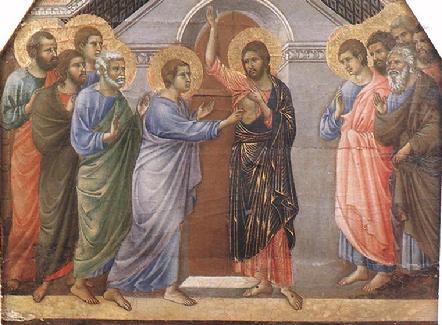Easter II
" who has opened the way "
Once, while cradling her beloved baby in her arms, Yashoda watched the child yawn. She saw the whole universe inside Krishna’s tiny mouth. Trembling with awe, she prayed she’d never see this frightening and magnificent truth again.
The image of the universe within baby Krishna’s mouth came to mind while reflecting upon this week’s Gospel lesson - the resurrected Jesus inviting Thomas to touch the wound in Jesus’ side. Julian of Norwich writes of this wound as a “fair and delectable place, large enough for all mankind.” Bruno Barnhart (OSBCam) likens the wound to the “promised land and paradise” of the unitive way.
Bruno’s rich quote can take your thoughts into many potential directions. However, his phrase “interior sabbath” might draw you to make connections with the third meditation prompt, Gordon Lathrop’s description of the Eighth Day as Christian worship. May your meditations be fruitful! -Suzanne
Link to this Sunday's Lessons here
|
Meditation One
"a fair and delectable place"
With a kindly countenance our good Lord looked into his side, and he gazed with joy, and with his sweet regard he drew his creature’s understanding into his side by the same wound; and there he revealed a fair and delectable place, large enough for all mankind that will be saved and will rest in peace and in love. And with that he brought to mind the dear and precious blood and water which he suffered to be shed for love. And in this sweet sight he showed his blessed heart split in two, and as he rejoiced he showed to my understanding a part of his blessed divinity, as much as was his will at that time, strengthening my poor soul to understand what can be said, that is the endless love which was without beginning and is and always shall be. – Julian of Norwich, Showings, ch.24, Paulist Press,p.220-221
|
 |
| Detail, The Incredulity of Thomas, Caravaggio, 1601-2 |
|
|
|
Second Sunday of Easter
Almighty and everlasting God, who in the Paschal mystery established the new covenant of reconciliation: Grant that all who have been reborn into the fellowship of Christ’s Body may show forth in their lives what they profess by their faith; through Jesus Christ our Lord, who lives and reigns with you and the Holy Spirit, one God, for ever and ever. Amen.
|
|
The Last Word
The mother can lay her child tenderly to her breast, but our tender Mother Jesus can lead us easily into his blessed breast through his sweet open side, and show us there a part of the godhead and of the joys of heaven, with inner certainty of endless bliss.
-Julian of Norwich (p.298)
|
 |
| The Incredulity of Thomas, Duccio |
|
|
|
Meditation Two
"you will see heaven opened"
Thomas has insisted upon personal contact and even a kind of physical intimacy – placing his finger and hand into Jesus’ wounds. Instead, he is given something different which is more personal and more intimate: the interior “touch” which is unitive experience of the Spirit. Blessed are those for whom this spiritual contact suffices; they shall be rich in the fullness of the Lord’s interior presence, and in the purity and strength of their faith. …
The passage from one kind of knowledge to another, from the knowledge of external sight to the knowledge of union, to which Jesus has led these disciples – and last of all Thomas – corresponds to his promise, “…you will see heaven opened…”(1:51). It is this initiation into the final unitive knowledge of God which is implied also in the final verse of John’s prologue:
No one (ie. not even Moses; see 1:17) has ever seen God. It is God the only Son, who is in the Father’s bosom, who has made him known (1:18).
Or, more graphically, “…who has opened the way” … The promised opening of the heavens is accomplished in the opening of “the Father’s bosom” to those who believe in Jesus. This opening of the interior sabbath of God’s rest to humanity is symbolized by the opened bosom of Jesus …This is the promised “place” (14:2-4), promised land and paradise. These convergent spatial images, however, all refer to a relationship which is non-spatial, non-dual and beyond all images: the simple divine union.
-Bruno Barnhart, The Good Wine: Reading John from the Center
|
|
Meditation Three
"on the eighth day"
The meeting is called a meeting on the eighth day because it opens toward what cannot be reached simply by more days like those of the seven-day weeks we have known. In the meeting on the first day there is an opening toward the day beyond days, toward the last day of God. It is the eighth day because Christians have met “eight days later” (John 20:26) down through the ages. That meeting has always meant for them the encounter with the risen one and so with the end of death and the endless cycles of loss. To encounter Christ risen is to encounter God’s spirit and God’s mercy, things that have been promised for the last day when God’s dwelling is to be with humankind and tears are to be wiped away. Christians believe the eighth -day meeting is already the dawning of that day.
The eighth day is the beginning of a new creation.
-Gordon W. Lathrop, Holy Things
|
|